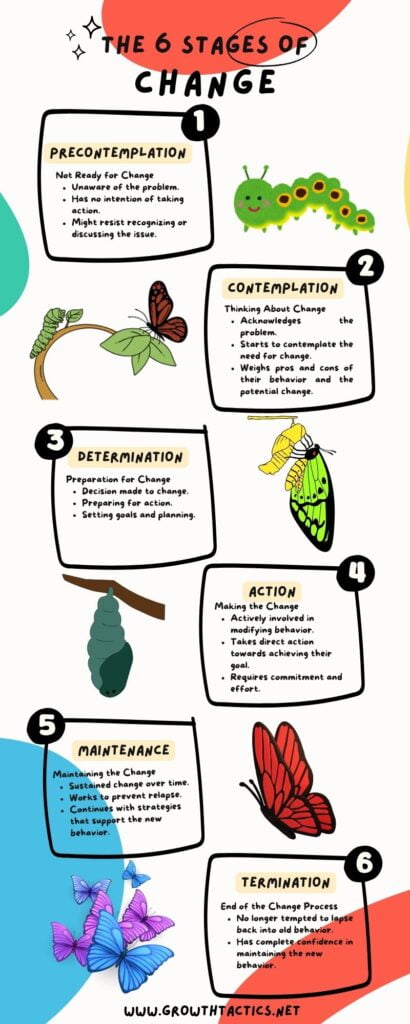Understanding transformational leadership strategies is very important in the age we live in. Businesses are constantly adapting to better meet the needs of their customers.
Look at Google, the company started as just a simple search engine and has grown into so much more. They are constantly updating their business, coming up with new ways to do things, and finding new ways to fill needs.
As leaders, we must adapt and lead our teams through change. If we are stuck in our ways and can’t change with the times, we may get left behind in the company. The change will normally start with the leaders. We must see opportunities to grow and get our teams on board with the change. The best way to do this is by being a transformative leader.
The stages of change below, also called The Transtheoretical Model, was developed by Prochaska and DiClemente in the late 1970s based on how people quit bad habits like smoking or drinking. Understanding this model can be great for not only personal growth but also leadership development because these stages directly translate into something that can help guide us through change as leaders. Making us a better transformational leader.

Jump To Section
Transformational Leader Characteristics
Transformational leaders exhibit the following characteristics and traits:
- Charisma – Charisma is one of the key characteristics of transformational leadership, as it enables leaders to inspire and motivate their followers toward a common goal.
- Adaptability – Leaders who are adaptable are able to respond to changes in their environment and adjust their strategies accordingly.
- Willing to Take Risks – Leaders who are willing to take risks are able to push the boundaries and explore new possibilities.
- Visionary – A transformational leader with a strong vision is able to provide direction for their team and create a sense of purpose.
- Curious – Transformational leaders who are curious are able to ask thought-provoking questions, and they encourage their team members to do the same.
- Good Communicators – Transformational leaders are effective communicators who are able to articulate their vision, inspire their team members, and foster a culture of collaboration and innovation.
- Inspirational – Transformational leaders are able to inspire their team members to work towards a shared vision, and they are able to create a sense of purpose and meaning in their work.
The 6 Stages of Change and How to Use Them to Be a Better Transformational Leader

The 6 stages of change are:
- Precontemplation
- Contemplation
- Determination
- Action
- Maintenance
- Termination

Transformational Change Stage One
Precontemplation is the first stage. In this stage, people don’t see a problem or a need for change. There are four main reasons for this stage, called the “Four Rs”.
Reluctant is the first reason. These are people that are reluctant to consider change because of a lack of knowledge or lack of motivation. Rebelliousness is the second reason. These people rebel against change because they believe they are being told what to do. Resigned is the third reason. These people may have made attempts in the past to change but believe they are unable to make the change due to those failed attempts. Rationalizing is the fourth reason. These people make excuses and rationalize why the change is not needed.
Leader’s Perspective
As transformational leaders, it’s important for us to understand that change is not always easy, and our team members may go through a range of emotions when faced with a new initiative or shift in direction. It’s not uncommon for employees to feel reluctant, resistive, or even resigned to the changes that are happening around them. They may have concerns about how the change will impact them or their work, or they may simply be resistant to change in general.
Recognizing these barriers to change is essential if we want to get our team on board and fully engaged in the change process. By anticipating these issues, we can take proactive steps to address them and help our team members overcome their resistance.
For example, if we know that our team members are likely to be resistant to change, we can take steps to communicate the benefits of the change and help them see how it will benefit them personally. We can also involve them in the decision-making process and solicit their input and feedback, which can help to create a sense of ownership and buy-in.
If our team members are feeling resigned or discouraged, we can provide them with support and resources to help them adapt to the change. This might include training, coaching, or mentoring, as well as regular check-ins to monitor their progress and provide feedback and encouragement.
It’s also important to recognize that some team members may rationalize excuses for why the change is not needed or won’t work. In these cases, we need to be prepared to provide clear and compelling evidence for why the change is necessary and how it will benefit the organization as a whole.
See Related: How to Be More Charismatic (21 Surefire Ways)
Transformational Change Stage Two
Contemplation is the second stage. People in this stage have begun to see there is a problem. They begin to gather information and resources to help them make the change. They begin to build the pros and cons and see many of the negatives of not changing. Although negatives are acknowledged, people in this stage are still on the fence about making the change.
Leader’s Perspective
The stage where transformational leaders need to discuss the need for change is often the most critical and challenging part of the change process. This is where leaders have to articulate the reasons why change is necessary, and help employees understand why it is important for the organization as a whole.
One of the key strategies that transformational leaders can use during this stage is to help employees see the need for change for themselves. While it is important for leaders to provide direction and guidance, ultimately it is up to each individual employee to decide whether or not they are willing to change. By helping employees see the need for themselves, leaders can create a sense of ownership and buy-in that is essential to the success of the change initiative.
To accomplish this, transformational leaders must utilize their power of influence and share their vision with their team. They must be able to communicate the benefits of the change in a way that resonates with each individual employee, and they must be able to inspire their team to take action.
One effective way to do this is to focus on the positive outcomes that the change will bring. This might include increased efficiency, improved customer satisfaction, or new growth opportunities for the organization. By highlighting these benefits, leaders can create a sense of excitement and enthusiasm that can help to overcome any resistance or reluctance to change.
Another important strategy is to involve employees in the change process as much as possible. This might include soliciting their input and feedback, encouraging them to share their thoughts and ideas, and providing opportunities for them to take ownership of the change initiative. When employees feel like they are part of the solution, they are more likely to be invested in the success of the change initiative.
Learn how to increase your circle of influence with your employees.
Transformational Change Stage Three
Determination is the third stage. This is the stage where a person has decided to act and make a change. The pros of change have finally begun to outweigh the cons. In this stage, people develop a plan on how to change. Most individuals that make it to this stage, at least make a serious attempt to change.
Leader’s Perspective
The stage where employees have decided to get on board with the change is an exciting and pivotal moment for transformational leaders. It signifies that the hard work of persuading and inspiring employees to embrace change has been successful and that the team is now ready to move forward in implementing the change.
During this stage, it is important for transformational leaders to continue to involve their employees as much as possible in the change process. This means seeking out their input and feedback on how to make the change work, and encouraging them to take an active role in planning and implementing the change.
One effective way to do this is to create cross-functional teams or task forces that are responsible for different aspects of the change initiative. By involving employees from different departments or areas of the organization, leaders can ensure that everyone has a voice in the process and that the change is implemented in a way that is aligned with the needs and goals of the entire organization.
Another important strategy during this stage is to provide employees with the resources and support they need to help make the change a reality. This might include providing additional training or education, offering incentives or rewards for successful implementation, and creating a culture of collaboration and teamwork that encourages employees to work together towards a common goal.
It is also important for transformational leaders to be open to constructive criticism and feedback from their employees during this stage. This means actively soliciting input and feedback and being willing to make adjustments and modifications to the change initiative based on the feedback received.

Click here to learn how to make a vision statement that motivates and inspires.
Transformational Change Stage Four
Action is the fourth stage. The plan is put into action in this stage. Many times, people in this stage will let others know they are making the change. This helps them stay committed to their efforts. They may even seek help from others to stick with the change.
Leader’s Perspective
The stage where a transformational leader puts their team’s plan into action is a crucial phase of the change process. It is the point where the rubber hits the road, and the proposed changes are tested in the real world. During this stage, it is important for leaders to keep their employees involved and engaged in the process, as doing so can help to reinforce the change and reduce the likelihood of major setbacks.
One way that transformational leaders can keep their employees involved during this stage is by providing clear communication and direction. This means being transparent about the goals and objectives of the change initiative, explaining what is expected of each employee, and setting clear timelines and milestones for progress. By doing so, leaders can help to create a sense of purpose and direction, and ensure that everyone is on the same page.
Another important strategy during this stage is to provide ongoing training and support for employees. This might include additional coaching or mentoring, access to new tools or technology, and opportunities for skill-building and professional development. By investing in their employee’s growth and development, leaders can help to build a culture of continuous improvement and innovation, which can be essential for driving long-term success.
In addition, it is important for transformational leaders to be open to feedback and suggestions from their employees during this stage. This means soliciting input and ideas from team members and being willing to make adjustments and modifications to the plan as needed. By doing so, leaders can demonstrate their commitment to collaboration and teamwork, and help to ensure that the change initiative is implemented in a way that is aligned with the needs and goals of the entire organization.
Transformational Change Stage Five
Maintenance is the fifth stage. In this stage, people build patterns over time. This is the stage where the change is sustained over a long time. During this stage, individuals may begin to let their guard down and relapse is possible. After relapse, if they can recommit to the change they typically learn from the relapse and build skills to prevent relapse in the future.
Leader’s Perspective
As a transformational leader, your job is not done once your team has successfully implemented the change initiative. It is important to continue to monitor the team closely for any signs of regression or setbacks, as these can have a significant impact on the success of the change effort.
During this stage, it is important to remain vigilant and be on the lookout for any signs that the team is reverting back to their old ways. This might include changes in behavior, decreased productivity, or a lack of enthusiasm for the new changes. By catching these issues early and addressing them promptly, leaders can prevent them from becoming complete regressions and derailing the change initiative.
In addition to monitoring for regression, it is also important to recognize and celebrate progress. By acknowledging the hard work and dedication of team members, leaders can help to reinforce the change and motivate employees to continue to embrace the new ways of working. This might include providing positive feedback, offering rewards or incentives for successful implementation, or recognizing team members publicly for their contributions.
Another important strategy during this stage is to continue to provide ongoing training and support for employees. This might include refresher courses or additional coaching, to help ensure that team members are equipped with the skills and knowledge they need to continue to succeed in the new environment.
Transformational Change Stage Six
Termination is the sixth and final stage. In this stage, the individual has no or little temptation to return to their old ways. The risk of relapse is very low at this stage. This person has complete confidence that they are not going to return to their old ways.
Leader’s Perspective
During this stage, it is important to continue to monitor the team for any signs of regression or setbacks, but these are much less likely to occur. The team has fully embraced the new ways of working and is motivated to continue to improve and innovate. As a leader, it is important to recognize and celebrate this achievement, and to continue to provide ongoing support and training to ensure that the team remains engaged and motivated.
One important strategy during this stage is to encourage a culture of continuous improvement and innovation. This means fostering an environment where team members feel empowered to suggest new ideas and approaches, and where experimentation and risk-taking are encouraged. By doing so, leaders can help to ensure that the team remains nimble and adaptable, and is able to respond quickly to changing circumstances.
Another key strategy during this stage is to continue to provide ongoing training and support. This might include periodic refresher courses or advanced training sessions, to help team members stay up-to-date with the latest best practices and technologies. By investing in the ongoing development of team members, leaders can ensure that the team remains competitive and productive over the long term.

Transformational Leadership Examples
- Bill Gates – He transformed the world with his company Microsoft by changing the ways computers operated.
- Mark Zuckerberg – He transformed the way people communicated and stayed close with Facebook.
- Abraham Lincoln – He transformed a whole country by passing laws for equal rights.
- Martin Luther King – He was another leader who transformed the country with his vision of equal rights.
Embracing Transformational Change in Your Company Culture
Understand the Need for Change
Before you begin to integrate transformational change into your corporate culture, recognize why change is necessary. Senior leaders should identify market demands that call for a significant shift. This understanding will craft a stronger sense of urgency for the change.
Communicate the Vision
Effective communication is the cornerstone of any successful transformation. Share the new vision and future direction with the entire organization. Ensure messages are clear, and consistent, and convey a better future for all.
Lead by Example
Leadership team members must become role models. They embody new behaviors and show commitment to the strategic plan. People managers and business leaders act as change leaders, inspiring others at the individual level.
Introduce New Behaviors
Organizational culture evolves when new behaviors are encouraged and rewarded. Performance reviews should align with desired changes. Establish incentives that support employee engagement and the adoption of the new direction.
Foster Leadership at All Levels
Transformation isn’t solely a top-down process. Change leaders emerge from all levels. Encourage strong leadership, and support those showing initiative with coaching and resources to drive sustainable change.
Implement in Stages
Change doesn’t happen overnight. Follow a series of phases or an eight-step model like that proposed by Dr. John Kotter. This provides structure to the transformation effort and helps manage the pace of implementation.
Involve HR Professionals
HR plays a pivotal role in transformational change. They help align internal structures with the new vision, guide the change management process, and work on employee engagement strategies.
Reinforce and Evaluate
As change initiatives progress, consistent communication is vital. Reinforce the benefits of the new technology, developmental change, or business strategy you’re implementing. Regularly evaluate progress and remain open to necessary adjustments for a successful transformation.
Celebrate Successes
Acknowledging and celebrating milestones builds momentum and a positive attitude towards the ongoing change. It validates the team’s hard work and fosters a connection to the new organizational culture.
Ensure Alignment
Every aspect of your business, from corporate culture to customer experience, should align with the changes. This alignment ensures that the transformational change is not only adopted but also becomes a natural part of the company’s evolution.
By embedding these practices into your business transformation, you create an environment ripe for developmental change that maintains a competitive advantage and gears the organization toward a vibrant and success-oriented future.
How to Use This in Leadership
Although this was developed based on alcoholism, this can be useful in many leadership situations involving change. Knowing these stages can be very beneficial for becoming a transformational leader. Help those around you see the need for change. Then develop a plan for change. Once a plan is developed, help them implement the plan. Guide them through the change helping them make the new processes and habits. When they become habits long enough, these habits will become the new normal. Until it is the new normal, help keep individuals accountable and on track.
You may also like 10 Common Types of Leadership Styles and How to Use Them.
If you enjoyed this article on transformational leadership strategies, please share and subscribe using the buttons below.


